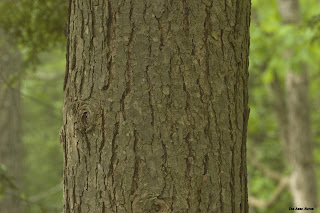Common Name: Canadian Hemlock, Eastern Hemlock
Family: Pinaceae
 Hopmeadow St, Simsbury, CT
Hopmeadow St, Simsbury, CT
Plant is Native to: Eastern North America; Hardy to Zone 3.
Plant Height at maturity: 40 to 70 feet tall, up to 100 feet in wild; 25 to 40 foot spread.
Plant Habit and Form: a needle evergreen. Conical or pyramidal shape in youth, and becoming pyramidal and pendulous in maturity. Soft, graceful structure, with horizontal to pendulous branches. Fine texture.
Foliage: Needles are flattened, about .25 to .75 inch long. Dark green on top, two white bands below. Leaf margins have minute serrulations. New spring growth light yellow-green, changes to glossy dark green.

 West Simsbury, CT
West Simsbury, CT
Bark: Brown. Smooth when young, then flaky and scaly, then has wide flat ridges with age. Deeply furrowed on old trees. Freshly cut surfaces show purplish streaks.
 West Simsbury, CT
West Simsbury, CT
Flower: Monoecious, with male and female flowers. Small, not ornamentally significant.
Fruit/Seed: Small slender cones, about .5 to 1 inch long. Light brown in fall. Hang from branches like small oval ornaments. Can have large numbers.
Growing Requirements: Full sun or partial shade. Prefers cool, moist, well-drained soils. Avoid hot, dry and windy locations.
Problems and Drawbacks: Hemlock wooly adelgid, a pest that can kill a plant in 3 years if untreated, has been a real problem in New England and mid-Atlantic states. It is now less of a problem, but still an issue, especially where nitrogen fertilizer has been used (increases susceptibility to the wooly adelgid). Intolerant of pollution, salt, heat or drought. Deer eat the foliage and rub off the bark. Scale, spider mites also may be a problem. Sunscorch may occur when temperatures reach 95 degrees and higher.
Special Uses: Specimen tree, or in groupings as a hedge or screen. Can be pruned in spring for use as hedge; prune individual shoots rather than sheering, for best effect.
ID Tips/Remarks: Short flattened needles, arranged in 2 by 2 fashion. Shoots are pubescent. Confused with T. caroliniana, but has more ,spirally distributed. Also, T. canadensis has minutely serrulated needle margins, while T. caroliniana has smooth margins.
Bibliography:
http://www.hort.uconn.edu/Plants/t/tsucan/tsucan1.html
Dirr, Michael A. Manual of Woody Landscape Plants, 1998 Stipes Publishing, Champaigne, IL
No comments:
Post a Comment